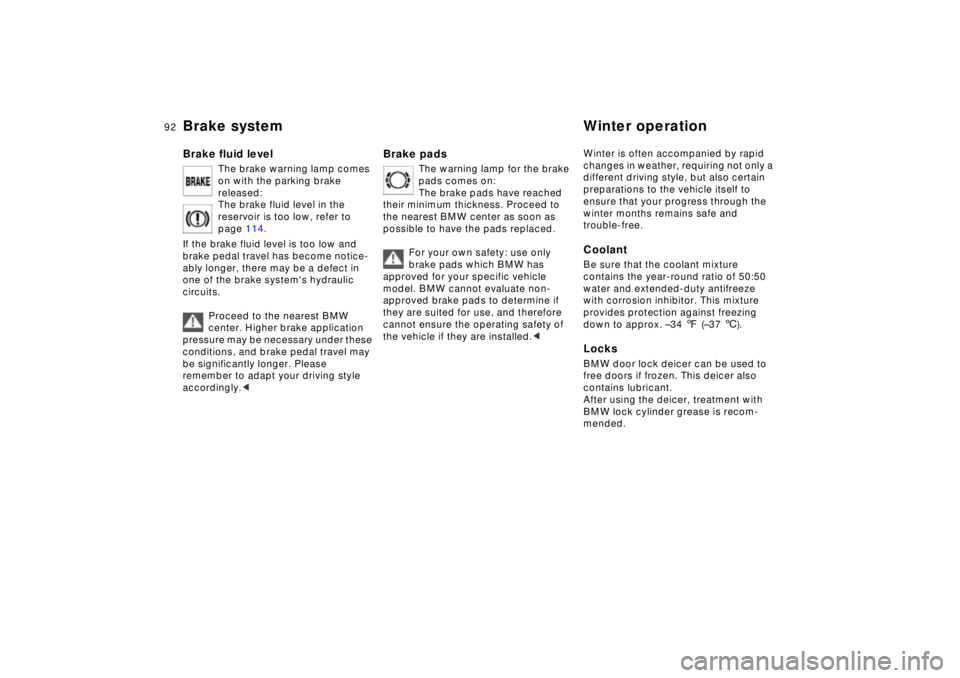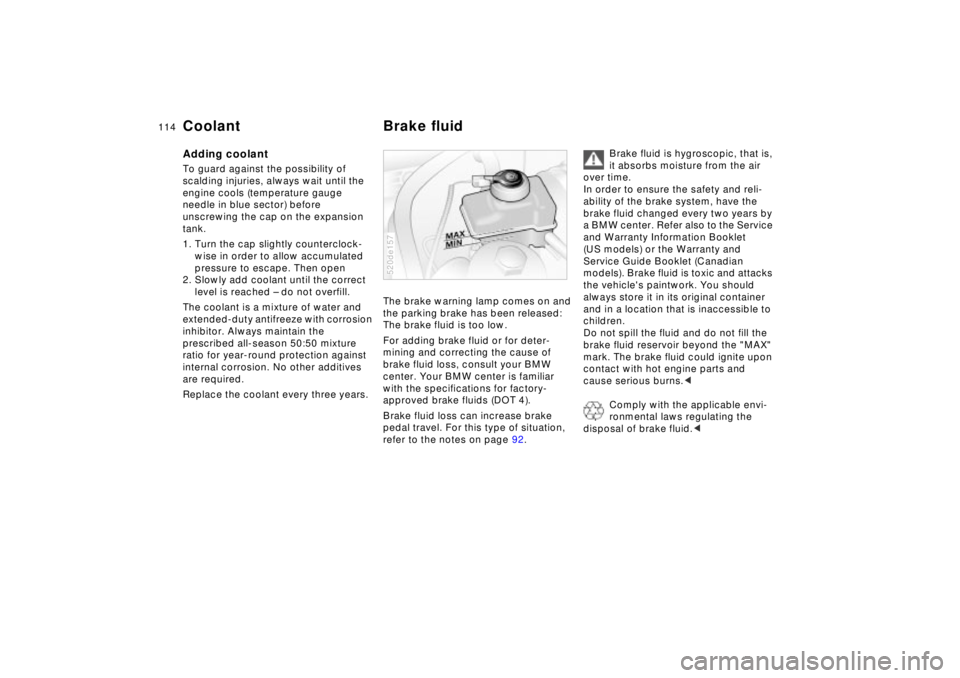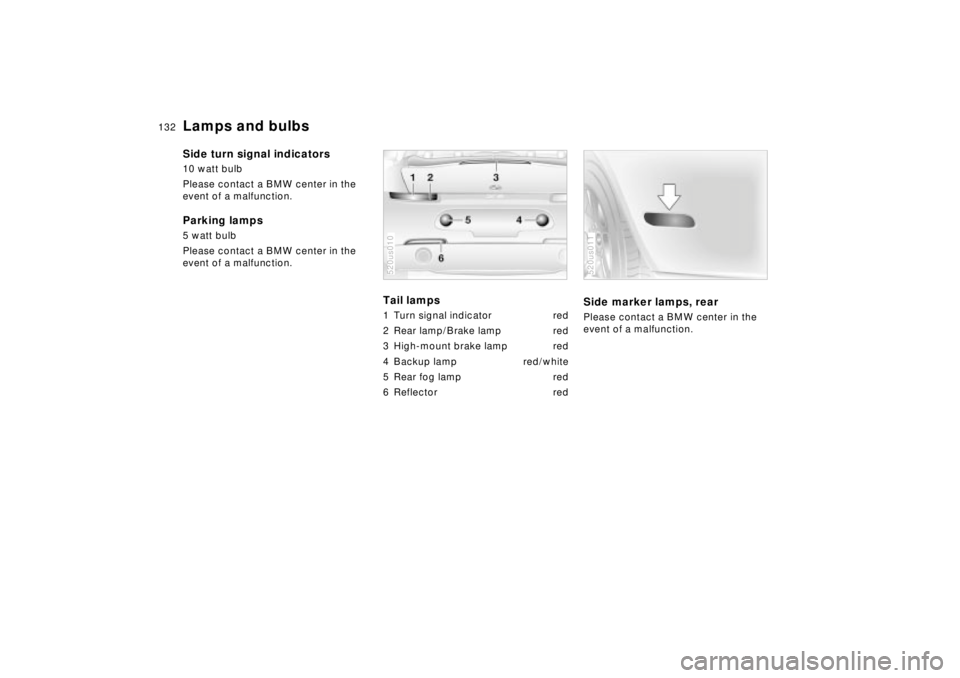2002 BMW Z8 parking brake
[x] Cancel search: parking brakePage 86 of 174

86n
To ensure that your vehicle provides
maximum economy throughout an
extended service life, we request that
you comply with the following informa-
tion.
Your BMW Z8 is an especially
high-quality vehicle. To protect
your own investment, we recommend
that you follow he break-in instructions
carefully. By doing so, you will create
the basis for optimal service life of the
vehicle.<
Engine and differentialUp to 1,200 miles (2,000 km):
Drive at varying engine and road
speeds, but do not exceed 4,500 rpm
or a road speed of 106 mph (170 km/h).
Comply with local and state maximum
speed limits.
Avoid depressing the accelerator to the
full-throttle position.
Following the Break-In Inspection at
1,200 miles (2,000 km), you can gradu-
ally increase engine or road speeds.
You should also comply with these
break-in procedures if the engine or
differential is replaced later in the
course of the vehicle's service life.TiresOwing to technical factors associated
with their manufacture, tires do not
achieve their full traction potential until
an initial break-in period has elapsed.
Thus drive with extra care during the
initial 200 miles (300 km).
Comply with local and state maximum
speed limits.
When the vehicle is being driven
on wet or slushy roads, a wedge
of water may form between the tire and
the road surface. This phenomenon is
referred to as "aquaplaning" and can
lead to partial or complete loss of trac-
tion, vehicle control and braking effec-
tiveness. Reduce your speed on wet
roads.<
Brake systemApproximately 300 miles (500 km) must
elapse before the brake pads and
rotors achieve the optimal pad-surface
and wear patterns required for trouble-
free operation and long service life.
To break in the separate parking brake
drums, apply the parking brake lightly
when coasting to a standstill (at a traffic
signal, for instance), provided that
traffic conditions allow you to do so.
To avoid corrosion, repeat this proce-
dure from time to time.
The brake lamps do not come
on when the parking brake is
engaged.
Vacuum for the brake system servo unit
on your BMW is available only when the
engine is running. When you move the
vehicle with the engine shut off Ð when
towing, for instance Ð substantially
higher levels of pedal force will be
required to brake the vehicle.
(500 km). Engage the gears carefully
and without high engine speeds during
this break-in period.
Break-in procedures
Page 87 of 174

87n
IndexDataTechnologyRepairsCar careControlsOverview
Brakes:
Do not rest your foot on the brake
pedal while driving. Even light but
consistent pressure on the brake pedal
could lead to high temperatures, brake
wear, and possibly, to brake system
failure.
Aquaplaning:
Reduce speed while driving on wet or
slushy roads, otherwise, a wedge of
water can form between the tires and
the road surface. This phenomenon is
referred to as "aquaplaning" or "hydro-
planing." It is characterized by a partial
or complete loss of contact between
the tires and the road surface. The ulti-
mate results are loss of steering and
braking control.
Driving through water:
When there is water on the roads, do
not drive in it if it is deeper than 1 ft
(30 cm), and even then, only at walking
speed, otherwise the vehicle can
sustain damage to the engine, the elec-
trical systems and the transmission.<
The catalytic converter reduces harmful
exhaust emissions.
It is designed for use with unleaded fuel
only. Even minute quantities of lead
would be enough to permanently
damage both the catalytic converter
and the system's oxygen sensor.
To ensure efficient, trouble-free engine
operation and to avoid potential
damage:
>Be sure to comply with the scheduled
maintenance requirements
>Fill the fuel tank well before it is empty
>Tow-start only when the engine is
cold. If you attempt to tow-start with
a warm engine, unburned residual
fuel could ignite on the way to the
catalytic converter and cause
damage. It is better to start the
vehicle with a battery charger or
assistance from another vehicle
>Avoid other situations where the fuel
is either not burned or burns incom-
pletely, such as engaging the starter
frequently or for extended periods, or
repeated start attempts in which the
engine does not start (stopping and
restarting an engine which is running
properly does not present a problem).
Never allow the engine to run with
any of the spark plug cables discon-
nected.Be sure to comply with the
instructions above to prevent
unburned fuel from reaching the cata-
lytic converter. Otherwise, there is the
danger of overheating and damage to
the catalytic converter.
Extreme temperatures are present with
the catalytic converter both on this and
every catalyst-equipped vehicle. Heat
shields are installed adjacent to some
sections of the exhaust system. Never
remove these shields; do not apply
undercoating to their surfaces. When
driving, standing at idle, and parking
the vehicle, take care to avoid contact
between the exhaust system and flam-
mable materials (grass, hay, leaves
etc.). Such contact could start a fire,
resulting in serious personal injury and
property damage.<
Driving notes Catalytic converter
Page 92 of 174

92n
Brake system Winter operationBrake fluid level
The brake warning lamp comes
on with the parking brake
released:
The brake fluid level in the
reservoir is too low, refer to
page 114.
If the brake fluid level is too low and
brake pedal travel has become notice-
ably longer, there may be a defect in
one of the brake system's hydraulic
circuits.
Proceed to the nearest BMW
center. Higher brake application
pressure may be necessary under these
conditions, and brake pedal travel may
be significantly longer. Please
remember to adapt your driving style
accordingly.<
Brake pads
The warning lamp for the brake
pads comes on:
The brake pads have reached
their minimum thickness. Proceed to
the nearest BMW center as soon as
possible to have the pads replaced.
For your own safety: use only
brake pads which BMW has
approved for your specific vehicle
model. BMW cannot evaluate non-
approved brake pads to determine if
they are suited for use, and therefore
cannot ensure the operating safety of
the vehicle if they are installed.<
Winter is often accompanied by rapid
changes in weather, requiring not only a
different driving style, but also certain
preparations to the vehicle itself to
ensure that your progress through the
winter months remains safe and
trouble-free. CoolantBe sure that the coolant mixture
contains the year-round ratio of 50:50
water and extended-duty antifreeze
with corrosion inhibitor. This mixture
provides protection against freezing
down to approx. Ð34 7 (Ð37 6).LocksBMW door lock deicer can be used to
free doors if frozen. This deicer also
contains lubricant.
After using the deicer, treatment with
BMW lock cylinder grease is recom-
mended.
Page 94 of 174

94n
Winter operation Power steering Cellular phone Skid control Depress the clutch and release the
accelerator pedal. Countersteer care-
fully and attempt to regain control over
the vehicle.ParkingEngage first or reverse gear. Depending
on the steepness of the incline, you can
apply the parking brake as well. In order
to prevent the parking brake pads from
locking due to frost or corrosion, dry
them by gently applying the parking
brake as the vehicle is coming to a
stop. Make sure that following traffic is
not endangered.
The brake lamps do not come
on when the parking brake is
engaged.<
If there is a change in steering response
Ð e. g. difficult or over-responsive
steering Ð at increasing speeds, consult
a BMW center to have it checked.
If the power steering fails,
increased effort will be required to
steer the vehicle.<
Mobile communications systems
(cellular phone, radio, etc.) are
permitted with an output of up to
10 watts only. Mobile communications
devices not specifically designed for
use in your vehicle may trigger malfunc-
tions while you are operating your
vehicle. BMW can neither test nor
assume responsibility for every indi-
vidual product being offered on the
market. We recommend that you
consult your BMW center before
purchasing any device of this kind.
To ensure reliable and trouble-free
operation of your BMW, do not use any
cellular phones or other radio devices
where the antenna is located either
inside the passenger compartment or
otherwise not attached to the outside of
the vehicle.
You will find instructions for operating
your cellular phone in the supplemen-
tary Owner's Manual.
Page 114 of 174

114n
Coolant Brake fluidAdding coolant To guard against the possibility of
scalding injuries, always wait until the
engine cools (temperature gauge
needle in blue sector) before
unscrewing the cap on the expansion
tank.
1. Turn the cap slightly counterclock-
wise in order to allow accumulated
pressure to escape. Then open
2. Slowly add coolant until the correct
level is reached Ð do not overfill.
The coolant is a mixture of water and
extended-duty antifreeze with corrosion
inhibitor. Always maintain the
prescribed all-season 50:50 mixture
ratio for year-round protection against
internal corrosion. No other additives
are required.
Replace the coolant every three years.The brake warning lamp comes on and
the parking brake has been released:
The brake fluid is too low.
For adding brake fluid or for deter-
mining and correcting the cause of
brake fluid loss, consult your BMW
center. Your BMW center is familiar
with the specifications for factory-
approved brake fluids (DOT 4).
Brake fluid loss can increase brake
pedal travel. For this type of situation,
refer to the notes on page 92.
520de157
Brake fluid is hygroscopic, that is,
it absorbs moisture from the air
over time.
In order to ensure the safety and reli-
ability of the brake system, have the
brake fluid changed every two years by
a BMW center. Refer also to the Service
and Warranty Information Booklet
(US models) or the Warranty and
Service Guide Booklet (Canadian
models). Brake fluid is toxic and attacks
the vehicle's paintwork. You should
always store it in its original container
and in a location that is inaccessible to
children.
Do not spill the fluid and do not fill the
brake fluid reservoir beyond the "MAX"
mark. The brake fluid could ignite upon
contact with hot engine parts and
cause serious burns.<
Comply with the applicable envi-
ronmental laws regulating the
disposal of brake fluid.<
Page 124 of 174

124n
Vehicle storage
If the vehicle is to be stored for
more than three months, ensure
that the following service operations
are carried out first.<
Preparations for storageHave your BMW center perform the
following procedures:
1. Clean and apply a rust proofing
agent or other treatment to the
engine, engine compartment, under-
carriage, axles and major compo-
nents in accordance with approved
repair procedures. Wash the vehicle,
clean the interior and treat painted
and chromed parts. Clean the
weather-stripping around the hood,
luggage compartment and doors
2. Change engine oil and oil filter at
operating temperature. As an addi-
tional corrosion protection measure,
an anticorrosive agent can be added
to the engine in accordance with the
manufacturer's instructions
3. Check the coolant level and concen-
tration and top off if necessary
4. Check the fluid level of the wind-
shield washer fluid reservoir; top off
if necessary
5. Fill the fuel tank completely to
prevent the formation of condensa-
tion
6. Increase the tire inflation pressure to
51 psi (350 kPa).Before parking the vehicle1. Dry the parking brake and footbrake
by brake applications to prevent the
brake discs and drums from
corroding
2. Park the vehicle in a covered, dry,
and well-ventilated area. Place the
transmission in first gear or, if neces-
sary, chock the wheels to prevent the
vehicle from rolling. Do not engage
the parking brake
3. Remove the battery, charge it
completely and store it in a cool (but
frost-free) room
4. Remove the hardtop and store it
separately, refer to page 96
5. Close the convertible top.
During storageRecharge a battery that has been taken
out of the vehicle every six months. If it
is not recharged, it will not be service-
able. Every time the battery is
discharged, especially over extended
periods, its service life is reduced.Removing the vehicle from
storageRecharge the battery if the "Magic Eye"
turns black, refer to page 138.
Then have Inspection I performed by
your BMW center, including a brake
fluid replacement, if necessary. Refer to
the Service and Warranty Information
Booklet (US models) or the Warranty
and Service Guide Booklet (Canadian
models).
Page 132 of 174

132n
Lamps and bulbsSide turn signal indicators10 watt bulb
Please contact a BMW center in the
event of a malfunction.Parking lamps5 watt bulb
Please contact a BMW center in the
event of a malfunction.
Tail lamps 1 Turn signal indicator red
2 Rear lamp/Brake lamp red
3 High-mount brake lamp red
4 Backup lamp red/white
5 Rear fog lamp red
6 Reflector red520us010
Side marker lamps, rearPlease contact a BMW center in the
event of a malfunction.520us011
Page 169 of 174

Everything from A to Z
169n
IndexDataTechnologyRepairsCar careControlsOverview
Low traction road
surfaces93
Luggage compartment37
bulb replacement136t
capacity160
remote control35
Luggage compartment
lid37
emergency release37t
emergency release from
luggage compartment's
interior38MM+S tires103
Maintenance63, 116
Malfunction, ABS89
Manual transmission58
Map lamps71
Microfilter75
MIR (Multi-Information
Radio)64
Mirrors48
Mobile phones81, 94
Modifications,
technical6, 125
Multi-Information Radio
(MIR)64
NNavigation system, refer to
the radio Owner's Manual
Neckrest46
Neon lamps131OOBD interface socket126
Odometer62
Oil
additives111
consumption111
fill capacity161
quality112
specifications112
viscosity112
Oil change intervals, see the
Service and Warranty
Information Booklet (US
models) or the Warranty
and Service Guide Booklet
(Canadian models)
Oil dipstick111
Oil filter change161
Oil level
check111
indicator lamp21
Oil pressure
indicator lamp20
OILSERVICE63
Onboard tool kit130tOpening and closing
from the inside36
from the outside32
Operation in winter92
Outlets, ventilation72
Outside temperature
display64
PPaint, care119
Paintwork
minor repairs120
waxing120
Parking brake57
Parking lamps69, 70
bulb replacment132t
Parking, winter94
Performance158
Phone, refer to cellular
phone94
"Please fasten your safety
belt" warning lamp21
Pocket flashlight79
Pollen75
Power steering94
Power windows40
Pressure, tires26t, 99
monitoring67
RRadio64, 94
refer also to the radio
Owner's Manual
Radio reception95, 151
Rapid heating77
Reading lamps71
Rear fog lamp70
bulb replacement133t
Rear window
defroster60, 75
Rearview mirror48
Recirculated-air mode74
Refill washer
reservoir110t
Refueling25
Remaining fuel indicator62
Remote control33
Removing condensation
from the windows75t
Removing the vehicle from
storage124
Replacement keys30
Replacing fuses140t
Replacing lamps and
bulbs131t
Replacing windshield wiper
blades130t
Replenish washer
fluid110t
Reporting Safety Defects7